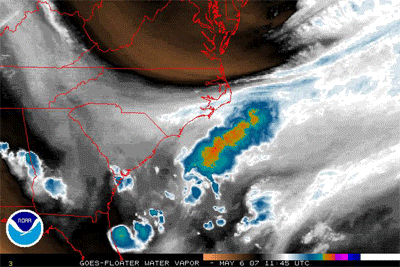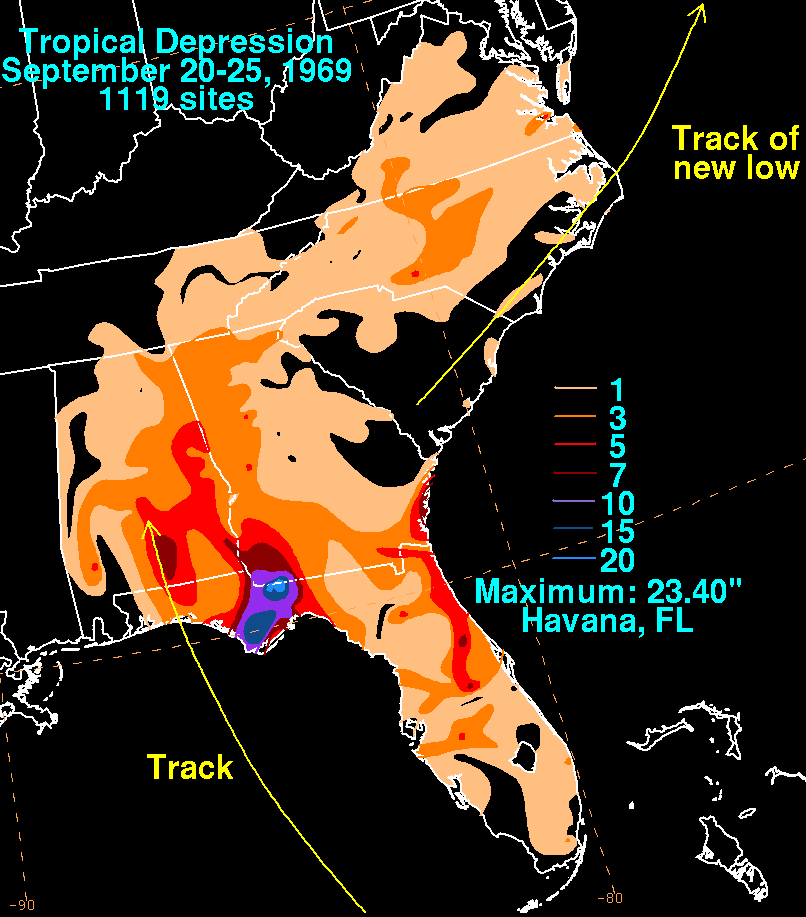|
Subtropical Storm Alpha (1972)
Subtropical Storm Alpha (also called Alfa) was an off-season subtropical cyclone that hit Georgia in May 1972. It developed from a previously non-tropical cyclone in the western Atlantic Ocean, and initially it moved northeastward off the Carolinas. The storm turned southwestward due to a building ridge, and concurrently it intensified to become Subtropical Storm Alpha. It later moved ashore near Savannah, and it finally dissipated in the northeast Gulf of Mexico on May 29. It produced wave action and moderate rainfall along the coast. Damage totaled over $100,000 (1972 USD), and there were two associated deaths. Meteorological history Throughout May 1972, a series of weak troughs moved across the eastern United States. In the third week of the month, an upper-level cutoff low developed along one of these troughs, located southeast of the United States and removed from the Westerlies. The origins of Alpha were from a surface low northeast of Florida, associated with the lar ... [...More Info...] [...Related Items...] OR: [Wikipedia] [Google] [Baidu] |
Southeastern United States
The Southeastern United States, also referred to as the American Southeast or simply the Southeast, is a geographical region of the United States. It is located broadly on the eastern portion of the southern United States and the southern portion of the eastern United States. It comprises at least a core of states on the lower East Coast of the United States and eastern Gulf Coast. Expansively, it reaches as far north as West Virginia and Maryland (bordered to north by the Ohio River and Mason–Dixon line), and stretching as far west as Arkansas and Louisiana. There is no official U.S. government definition of the region, though various agencies and departments use different definitions. Geography The U.S. Geological Survey considers the Southeast region to be the states of Alabama, Florida, Georgia, Arkansas, Kentucky, Louisiana, Mississippi, North Carolina, South Carolina, and Tennessee, plus Puerto Rico and the United States Virgin Islands. There is no official Census Bu ... [...More Info...] [...Related Items...] OR: [Wikipedia] [Google] [Baidu] |
Cape Fear, North Carolina
Cape Fear is a prominent headland jutting into the Atlantic Ocean from Bald Head Island on the coast of North Carolina in the southeastern United States. It is largely formed of barrier beaches and the silty outwash of the Cape Fear River as it drains the southeast coast of North Carolina through an estuary south of Wilmington. Cape Fear is formed by the intersection of two sweeping arcs of shifting, low-lying beach, the result of longshore currents which also form the treacherous, shifting Frying Pan Shoals, part of the Graveyard of the Atlantic. Dunes dominated by sea oats occur from the upper beach driftline back to the stable secondary dunes, where they mix with other grasses such as saltmeadow cordgrass and panic grass, as well as seaside goldenrod, spurge and other herbs to form a stable salt-tolerant grassland. The Cape Fear estuary drains the largest watershed in North Carolina, containing 27% of the state's population. History Giovanni da Verrazzano, the Italian e ... [...More Info...] [...Related Items...] OR: [Wikipedia] [Google] [Baidu] |
Tropical Storm Beryl (2012)
Tropical Storm Beryl was the strongest off-season Atlantic tropical cyclone on record to make landfall in the United States. The second tropical cyclone of the 2012 Atlantic hurricane season, Beryl developed on May 26 from a low-pressure system offshore North Carolina. Initially subtropical, the storm slowly acquired tropical characteristics as it tracked across warmer sea surface temperatures and within an environment of decreasing vertical wind shear. Late on May 27, Beryl transitioned into a tropical cyclone less than from North Florida. Early the following day, the storm moved ashore near Jacksonville Beach, Florida, with peak winds of 65 mph (100 km/h). It quickly weakened to a tropical depression, dropping heavy rainfall while moving slowly across the southeastern United States. A cold front turned Beryl to the northeast, and the storm became extratropical on May 30. The precursor to Beryl produced heavy rainfall in Cuba, causing flooding, mudslide ... [...More Info...] [...Related Items...] OR: [Wikipedia] [Google] [Baidu] |
Subtropical Storm Andrea (2007)
Subtropical Storm Andrea was the first named storm to form in May in the Atlantic Ocean in 26 years. Andrea caused large waves and tropical-storm force winds along the southeast coast of the United States. The first named storm and the first subtropical cyclone of the 2007 Atlantic hurricane season, Andrea developed out of a non-tropical low on May 9 about 150 miles (240 km) northeast of Daytona Beach, Florida, three weeks before the official start of the season. After encountering dry air and strong vertical wind shear, Andrea weakened to a subtropical depression on May 10 while remaining nearly stationary, and the National Hurricane Center discontinued advisories early on May 11. Andrea's remnant was subsequently absorbed into another extratropical storm on May 14. Andrea was the first pre-season storm to develop since Tropical Storm Ana in April 2003. Additionally, the storm was the first Atlantic named storm in May since Tropical Storm Arlene in 1981. The storm pro ... [...More Info...] [...Related Items...] OR: [Wikipedia] [Google] [Baidu] |
List Of Florida Hurricanes (1950–1974)
The list of Florida storms from 1950 to 1974 encompasses 85 Atlantic tropical or subtropical cyclones that affected the U.S. state of Florida. Collectively, tropical cyclones in Florida during the time period resulted in about $7.04 billion (2017 USD) in damage, primarily from Hurricanes Donna and Dora. Additionally, tropical cyclones in Florida were directly responsible for 93 fatalities during the period, as well as responsible for 23 indirect deaths. Several tropical cyclones produced over 20 inches (500 mm) of rainfall in the state, including Hurricane Easy which is the highest total during the time period. The 1969 season was the year with the most tropical cyclones affecting the state, with a total of 8 systems. The 1954 and 1967 seasons were the only years during the time period in which a storm did not affect the state. The strongest hurricane to hit the state during the time period was Hurricane Donna in 1960, which was the 8th strongest hurri ... [...More Info...] [...Related Items...] OR: [Wikipedia] [Google] [Baidu] |
Subtropical Storm Alpha (2020)
Subtropical Storm Alpha was the first subtropical or tropical cyclone ever observed to make landfall in mainland Portugal. The twenty-second tropical or subtropical cyclone and twenty-first named storm of the extremely active and record-breaking 2020 Atlantic hurricane season, Alpha originated from a large non-tropical low that was first monitored by the National Hurricane Center on 15 September. Initially not anticipated to transition into a tropical cyclone, the low gradually tracked south-southeastward for several days with little development. By early on 17 September, the low had separated from its frontal features and exhibited sufficient organization to be classified as a subtropical cyclone, as it approached the Iberian Peninsula, becoming a subtropical storm around that time. Alpha then made landfall just south of Figueira da Foz, Portugal during the evening of 18 September, then rapidly weakened as it moved over the mountainous terrain of Northeastern Po ... [...More Info...] [...Related Items...] OR: [Wikipedia] [Google] [Baidu] |
Tropical Storm Alpha (2005)
Tropical Storm Alpha was the 23rd tropical or subtropical storm of the extremely active 2005 Atlantic hurricane season. It developed from Tropical Depression Twenty-Five in the eastern Caribbean Sea on October 22, 2005. As the 21 pre-designated storm names had been exhausted, it was given the first name on the auxiliary list, which utilized the letters of the Greek alphabet. This was the first hurricane season ever to trigger this naming protocol, and the only one until the 2020 season. During its brief life, Alpha moved west-northwestward and reached its peak intensity on October 23, but weakened as it neared landfall in the Dominican Republic that same day. Crossing the island of Hispaniola it weakened to a tropical depression, and persisted until October 24, when it dissipated. Its remnant low was absorbed by Hurricane Wilma's large circulation. Alpha dumped torrential rain on the island of Hispaniola, making it the eighth wettest storm to impact poverty-stri ... [...More Info...] [...Related Items...] OR: [Wikipedia] [Google] [Baidu] |
Greek Alphabet
The Greek alphabet has been used to write the Greek language since the late 9th or early 8th century BCE. It is derived from the earlier Phoenician alphabet, and was the earliest known alphabetic script to have distinct letters for vowels as well as consonants. In Archaic Greece, Archaic and early Classical Greece, Classical times, the Greek alphabet existed in Archaic Greek alphabets, many local variants, but, by the end of the 4th century BCE, the Euclidean alphabet, with 24 letters, ordered from alpha to omega, had become standard and it is this version that is still used for Greek writing today. The letter case, uppercase and lowercase forms of the 24 letters are: : , , , , , , , , , , , , , , , , , /ς, , , , , , . The Greek alphabet is the ancestor of the Latin script, Latin and Cyrillic scripts. Like Latin and Cyrillic, Greek originally had only a single form of each letter; it developed the letter case distinction between uppercase and lowercase in parallel with Latin ... [...More Info...] [...Related Items...] OR: [Wikipedia] [Google] [Baidu] |
1973 Atlantic Hurricane Season
The 1973 Atlantic hurricane season was the first season to use the Saffir–Simpson hurricane scale, a scale developed in 1971 by Herbert Saffir and Robert Simpson to rate the intensity of tropical cyclones. The season produced 24 tropical and subtropical cyclones, of which only 8 reached storm intensity, 4 became hurricanes, and only 1 reached major hurricane status. Although more active than the 1972 season, 1973 brought few storms of note. Nearly half of the season's storms affected land, one of which resulted in severe damage. The season officially began on June 1, 1973, and lasted until November 30, 1973. These dates conventionally delimit the period of each year when most tropical cyclones form in the Atlantic basin. However, the first system formed on April 18, more than a month before the official start. Three more depressions formed before June 1; however, none attained storm intensity. The first named storm of the year was Hurricane Alice which formed on ... [...More Info...] [...Related Items...] OR: [Wikipedia] [Google] [Baidu] |
Neutercane A subtropical cyclone is a weather system that has some characteristics of both tropical and an extratropical cyclone. As early as the 1950s, meteorologists were uncertain whether they should be characterized as tropical or extratropical cyclones. They were officially recognized and titled by the Nationa |







